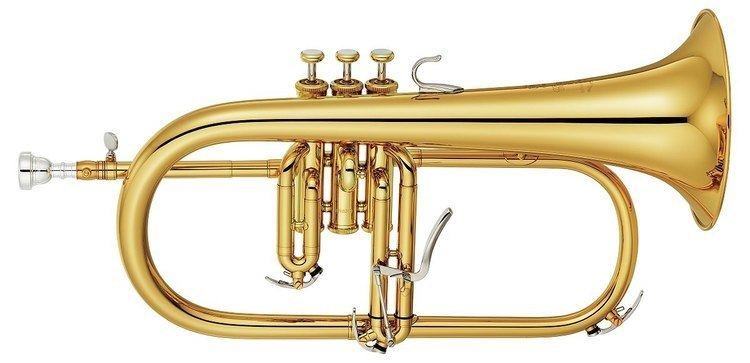Classification WindBrassAerophone | Developed Early 19th century | |
 | ||
Hornbostel–Sachs classification 423.232(Valved aerophone sounded by lip movement) | ||
The flugelhorn (/ˈfluːɡəl.hɔːrn/—also spelled fluegelhorn, flugel horn, or Flügelhorn—from German, wing horn, [ˈflyːɡl̩hɔʁn]) is a brass instrument pitched in B♭, and resembles a trumpet, but has a wider, conical bore. The instrument known today as the flugelhorn was developed from the valved bugle and is a member of the saxhorn family, which was developed by Adolphe Sax, who also created the saxophone family. The modern flugelhorn and Sax's B♭ soprano (contralto) saxhorn are practically the same instrument.
Contents
Etymology
The German word Flügel translates into English as wing or flank. The instrument was used on the battlefield to summon the flanks of an army.
Structure and variants
The flugelhorn is built in the same B♭ pitch as many trumpets and cornets. It usually has three piston valves and employs the same fingering system as other brass instruments, but four-piston valve and rotary valve variants also exist. It can thus be played without too much trouble by trumpet and cornet players, though some adaptation to their playing style may be needed. It is usually played with a more deeply conical mouthpiece than either trumpets or cornets (though not as conical as a horn mouthpiece).
Some modern flugelhorns feature a fourth valve that lowers the pitch a perfect fourth (similar to the fourth valve on some euphoniums, tubas, and piccolo trumpets, or the trigger on trombones). This adds a useful low range that, coupled with the flugelhorn's dark sound, extends the instrument's abilities. More often, however, players use the fourth valve in place of the first and third valve combination, which is somewhat sharp (compensated for on trumpets and cornets and some three-valve flugelhorns by a slide for the first or third valve).
A pair of bass flugelhorns in C, called fiscorns, are played in the Catalan cobla bands which provide music for sardana dancers.
Timbre
The tone is "fatter" and usually regarded as more "mellow" and "dark" than the trumpet or cornet. The sound of the flugelhorn has been described as halfway between a trumpet and a French horn, whereas the cornet's sound is halfway between a trumpet and a flugelhorn. The flugelhorn is as agile as the cornet but more difficult to control in the high register (from approximately written G above the staff), where in general it "slots" or locks onto notes less easily. It is not generally used for aggressive or bright displays as trumpets and cornets often are, but tends more towards a softer and more reflective role.
Use
The flugelhorn is a standard member of the British-style brass band, and it is also used frequently in jazz. It also appears occasionally in orchestral and concert band music. Famous orchestral works with flugelhorn include Igor Stravinsky's Threni, Ralph Vaughan Williams's Ninth Symphony, Danzon no. 2 by Arturo Marquez, and Michael Tippett's third symphony. The flugelhorn is sometimes substituted for the post horn in Mahler's Third Symphony, and for the soprano Roman buccine in Ottorino Respighi's Pines of Rome. In HK Gruber's trumpet concerto Busking (2007) the soloist is directed to play a flugelhorn in the slow middle movement. The flugelhorn figured prominently in many of Burt Bacharach's 1960s pop song arrangements. It is featured in a solo role in Bert Kaempfert's 1962 recording of "That Happy Feeling". Flugelhorns have occasionally been used as the alto or low soprano voice in a drum and bugle corps.
Another use of the flugelhorn is found in the Dutch and Belgian "Fanfareorkesten" or fanfare orchestras, in these orchestras the flugelhorns, often between 10-20 of them, have a huge role, forming the base of the orchestra. The flugelhorns in these orchestras are pitched in B-flat, with sporadically an E-flat soloïst. Due to bad intonation these E-flat flugelhorns are mostly being replaced by the E-flat trumpet or cornet.
Famous players
Joe Bishop, as a member of the Woody Herman band in 1936, was one of the earliest jazz musicians to use the flugelhorn. Shorty Rogers and Kenny Baker began playing it in the early fifties, and Clark Terry used it in Duke Ellington's orchestra in the mid-1950s. Chet Baker recorded several albums on the instrument in the 1950s and 1960s. Miles Davis further popularized the instrument in jazz on the albums Miles Ahead and Sketches of Spain, (both arranged by Gil Evans) though he did not use it much on later projects. Other prominent jazz flugelhorn players include Freddy Buzon, Freddie Hubbard, Tom Browne, Lee Morgan, Wilbur Harden, Art Farmer, Roy Hargrove, Hugh Masekela, Feya Faku, Tony Guerrero, Gary Lord, Jimmy Owens, Maynard Ferguson, Terumasa Hino, Woody Shaw, Guido Basso, Kenny Wheeler, Tom Harrell, Bill Coleman, Thad Jones, Arturo Sandoval, Lee Loughnane of the rock band Chicago, Mike Metheny, Harry Beckett, and Ack van Rooyen. Most jazz flugelhorn players use the instrument as an auxiliary to the trumpet, but in the 1970s Chuck Mangione gave up playing the trumpet and concentrated on the flugelhorn alone, notably on his jazz-pop hit song "Feels So Good". Mangione, in an interview on ABC during the 1980 Winter Olympics, for which he wrote the theme "Give It All You Got", referred to the flugelhorn as "... the right baseball glove."
Pop flugelhorn players include Probyn Gregory (Brian Wilson Band), Ronnie Wilson of the Gap Band, Rick Braun, Mic Gillette, Jeff Oster, Zach Condon of the band Beirut, and Scott Spillane of the band Neutral Milk Hotel. Marvin Stamm played the flugelhorn solo on "Uncle Albert/Admiral Halsey" by Paul McCartney and Wings.
